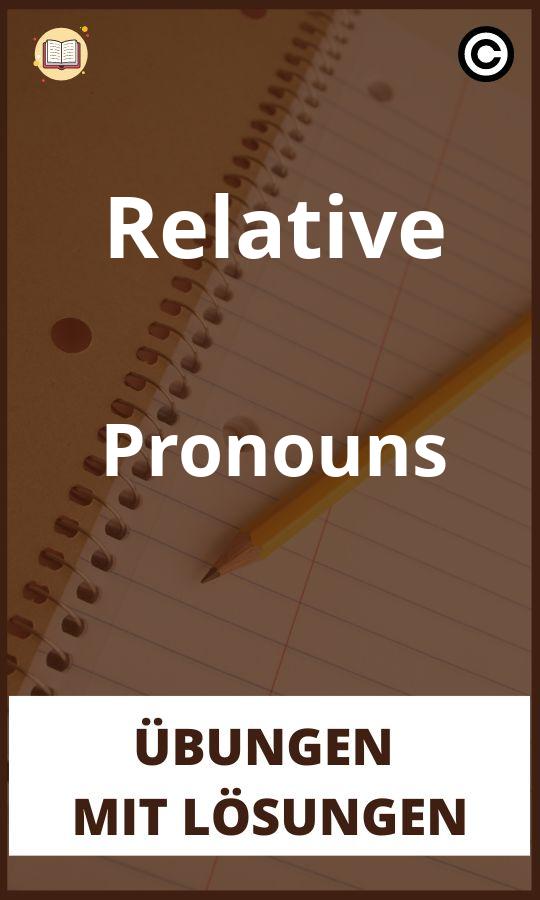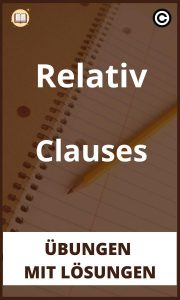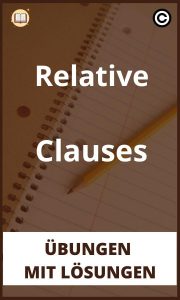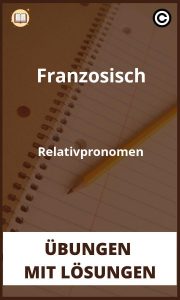
Öffnen – Übungen Relative Pronouns PDF
Relative Pronouns sind Wörter, die ein bestimmtes Nomen oder eine bestimmte Nomenklasse repräsentieren. In der deutschen Sprache gibt es drei relative Pronomen: der, die, das (der, die, das sind die relative Pronomen für männliche, weibliche und sächliche Nomen). Relative Pronomen können auch als Ersatz für ein bestimmtes Nomen oder eine bestimmte Nomenklasse verwendet werden. In diesem Fall werden sie als „Relativpronomen“ bezeichnet.
Zum Beispiel:
Der Mann, der auf der Straße steht, ist mein Vater.
Die Frau, die neben dem Mann steht, ist meine Mutter.
Das Kind, das zwischen den beiden steht, bin ich.
In diesem Beispiel wird das Wort „der“ als Ersatz für das Wort „Mann“ verwendet, und das Wort „die“ wird als Ersatz für das Wort „Frau“ verwendet.
Übungen mit lösungen zur Relative Pronouns
Übungen mit lösungen zur Relative Pronouns
1. Relative pronouns introduce relative clauses. They refer back to a noun or pronoun in the main clause, and they connect the relative clause to the main clause. The relative pronouns are who, whom, that, which, and where. Who and whom are used only for people. That can be used for people or things. Which is used only for things. Where is used for places. There are also two compound relative pronouns: whoever and whatever.
2. Who and whom are used as the subject or object of a relative clause. That can be used as the subject or object of a relative clause. Which can be used as the subject or object of a relative clause. Where can be used as the subject or object of a relative clause.
3. Who and whom are used when the relative clause is about people. That is used when the relative clause is about people or things. Which is used when the relative clause is about things. Where is used when the relative clause is about places.
4. Who and whom are used when the relative clause is the subject of the sentence. That is used when the relative clause is the subject or object of the sentence. Which is used when the relative clause is the object of the sentence. Where is used when the relative clause is the subject of the sentence.
5. Who and whom are used when the relative clause is the object of a verb. That is used when the relative clause is the subject or object of a verb. Which is used when the relative clause is the object of a verb. Where is used when the relative clause is the subject of a verb.
6. Who and whom are used when the relative clause is the object of a preposition. That is used when the relative clause is the subject or object of a preposition. Which is used when the relative clause is the object of a preposition. Where is used when the relative clause is the subject of a preposition.
7. Who, whom, that, which, and where can be used as the subject or object of a relative clause. Whoever and whatever can be used as the subject or object of a relative clause.
8. Who, whom, that, which, and where can be used as the subject or object of a relative clause. Whoever and whatever can be used as the subject or object of a relative clause.
9. Who, whom, that, which, and where can be used as the subject or object of a relative clause. Whoever and whatever can be used as the subject or object of a relative clause.
10. Who, whom, that, which, and where can be used as the subject or object of a relative clause. Whoever and whatever can be used as the subject or object of a relative clause.
Aufgaben zur Relative Pronouns
Relative Pronouns sind Wörter, die ein bestimmtes Nomen oder eine bestimmte Person in einem Satz identifizieren. Die häufigsten englischen Relative Pronouns sind who, whom, that, which, whose, where, when und why . Diese Wörter können in einem Satz als Subjekt, Objekt oder Possessivpronomen fungieren.
Die Relative Pronouns who, whom, that und which werden verwendet, um Menschen oder Sachen zu identifizieren. Die Relative Pronouns whose, where, when und why werden verwendet, um bestimmte Orte, Zeiten oder Gründe zu identifizieren.
Die Relative Pronouns who, whom, that und which können als Subjekt oder Objekt in einem Satz fungieren. Die Relative Pronouns whose, where, when und why können nur als Objekt in einem Satz fungieren.
Die Relative Pronouns who, whom, that, which, whose, where, when und why werden oft mit einem Verb in der Präposition of gefolgt. Die Präposition of kann auch mit anderen Wörtern wie the, this, that, these, those gefolgt werden.
Beispiele:
The man who is standing next to the car is my brother. (Der Mann, der neben dem Auto steht, ist mein Bruder.)
The woman whom you talked to yesterday is my sister. (Die Frau, mit der Sie gestern gesprochen haben, ist meine Schwester.)
This is the book that I was telling you about. (Das ist das Buch, von dem ich dir erzählt habe.)
The house which we saw yesterday is for sale. (Das Haus, das wir gestern gesehen haben, ist zum Verkauf.)
The man whose car was stolen is a friend of mine. (Der Mann, dessen Auto gestohlen wurde, ist ein Freund von mir.)
Do you know the place where I met her? (Kennst du den Ort, an dem ich sie getroffen habe?)
I don’t remember the day when we first met. (Ich erinnere mich nicht an den Tag, an dem wir uns das erste Mal getroffen haben.)
Do you know the reason why she left? (Weißt du, warum sie gegangen ist?)






